Optical studies of Dy2O3 doped phosphate glasses for potential white luminescence applications
IF 3.3
3区 化学
Q2 CHEMISTRY, INORGANIC & NUCLEAR
引用次数: 0
Abstract
Phosphate glasses with chemical compositions of (60-x) P2O5-15ZnO-15CaCO3-10Li2CO3-xDy2O3 (where x = 0, 0.25, 0.5, 0.75 and 1 mol %) have been synthesized by melt quenching method. The prepared glasses were characterized by various techniques such as X-ray powder diffraction (XRD), Atomic Force Microscopy (AFM), Differential Scanning Calorimetry (DSC), Fourier Transform Infrared Spectroscopy (FTIR), photoluminescence (PL) and Judd-Ofelt (JO) theoretical model. X-ray diffraction indicates that all samples have an amorphous structure. The Atomic Force Microscopy (AFM) observation of PZCL revealed smooth surface and high quality, characterized by specific roughness parameters (Ra = 2.540, Rz = 11.441, Rmax = 13.961, Rq = 3.100 nm) and presented in the form of 3D,2D surface topography. DSC measurements show that PZCLD1 have a good thermal stability among the sample and reached ΔT = 148 °C after adding Dy3+. The FTIR spectra confirming an increase of non-bridging oxygen (NBO) by addition of Dy2O3. The emission spectra presented three main bands at 491, 575 and 673 nm corresponding to the 4F9/2 → 6H15/2, 4F9/2 → 6H13/2 and 4F9/2 → 6H11/2 transitions, respectively. The luminescence concentration quenching point is observed at 0.5 mol % of Dy2O3. The Judd–Ofelt (JO) theory was applied to the absorption bands to determine the phenomenological parameters (Ω2, Ω4 and Ω6 calculated subsequently). It was discovered that the JO parameters are in the following order: Ω2> Ω4> Ω6. These parameters were then used to evaluate key radiative properties, including the total spontaneous transition probability (AT),the stimulated emission cross-section (σe), effective bandwidth (Δλeff),the radiative lifetime (τrad) and the radiative branching ratio (βrad) for excited luminescent states. The radiative lifetime of PZCLD0.5 τrad = 1.31 ms calculated by Judd–Ofelt theory and experimental lifetime exp = 0.98 ms for the level 4F9/2 decreases as Dy3+ concentration increases. Moreover, the quantum efficiency (η = 74.80 %) of PZCLD0.5 indicates that the present material holds strong potential as a candidate for laser emission at 575 nm. The CIE coordinates is found to be x = 0.333 and y = 0.334 revealed that the present sample falls within the white region. The typical CCT value of PZCLD0.5 is estimated to be around 5471 K.

Dy2O3掺杂磷酸盐玻璃的光学研究及其潜在的白光应用
采用熔体淬火法合成了化学成分为(60-x) P2O5-15ZnO-15CaCO3-10Li2CO3-xDy2O3 (x = 0、0.25、0.5、0.75和1 mol %)的磷酸盐玻璃。利用x射线粉末衍射(XRD)、原子力显微镜(AFM)、差示扫描量热法(DSC)、傅里叶变换红外光谱(FTIR)、光致发光(PL)和Judd-Ofelt (JO)理论模型对所制备的玻璃进行了表征。x射线衍射表明所有样品都具有非晶结构。原子力显微镜(AFM)观察表明,PZCL表面光滑,质量高,具有特定的粗糙度参数(Ra = 2.540, Rz = 11.441, Rmax = 13.961, Rq = 3.100 nm),并以三维、二维表面形貌的形式呈现。DSC测试表明,PZCLD1在样品中具有良好的热稳定性,加入Dy3+后达到ΔT = 148℃。FTIR光谱证实Dy2O3的加入增加了非桥氧(NBO)。发射光谱在491、575和673 nm处分别对应4F9/2→6H15/2、4F9/2→6H13/2和4F9/2→6H11/2跃迁。在0.5 mol %的Dy2O3浓度下观察到发光浓度的猝灭点。将Judd-Ofelt (JO)理论应用于吸收波段以确定现象学参数(随后计算Ω2, Ω4和Ω6)。发现JO参数的顺序如下:Ω2>;Ω4比;Ω6。然后利用这些参数来评估关键的辐射特性,包括总自发跃迁概率(AT)、受激发射截面(σe)、有效带宽(Δλeff)、辐射寿命(τrad)和辐射分支比(βrad)。在4F9/2能级上,Judd-Ofelt理论计算的PZCLD0.5 τrad = 1.31 ms和实验寿命τexp = 0.98 ms随Dy3+浓度的增加而减小。此外,PZCLD0.5的量子效率(η = 74.80%)表明该材料作为575 nm激光发射的候选材料具有很强的潜力。CIE坐标被发现为x = 0.333和y = 0.334,显示当前样本落在白色区域内。PZCLD0.5的典型CCT值估计在5471 K左右。
本文章由计算机程序翻译,如有差异,请以英文原文为准。
求助全文
约1分钟内获得全文
求助全文
来源期刊

Solid State Sciences
化学-无机化学与核化学
CiteScore
6.60
自引率
2.90%
发文量
214
审稿时长
27 days
期刊介绍:
Solid State Sciences is the journal for researchers from the broad solid state chemistry and physics community. It publishes key articles on all aspects of solid state synthesis, structure-property relationships, theory and functionalities, in relation with experiments.
Key topics for stand-alone papers and special issues:
-Novel ways of synthesis, inorganic functional materials, including porous and glassy materials, hybrid organic-inorganic compounds and nanomaterials
-Physical properties, emphasizing but not limited to the electrical, magnetical and optical features
-Materials related to information technology and energy and environmental sciences.
The journal publishes feature articles from experts in the field upon invitation.
Solid State Sciences - your gateway to energy-related materials.
 求助内容:
求助内容: 应助结果提醒方式:
应助结果提醒方式:


